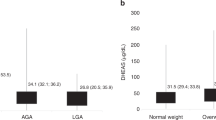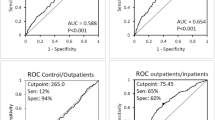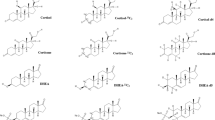Abstract
Age-related decline of plasma dehydroepiandrosterone-sulfate (DHEA-S) levels may be associated with the risk of cardiovascular disease in women. We investigated whether plasma DHEA-S levels are related to endothelial function in postmenopausal women with coronary risk factors. One hundred and fifteen postmenopausal women (mean age±SD: 57±5 years; range: 48−65 years) who underwent measurement of flow-mediated vasodilation (FMD) of the brachial artery using ultrasonography were enrolled. Plasma hormone levels were determined in the morning after a 14-h fast, and the relationship between hormone levels and FMD was analyzed. DHEA-S was significantly correlated with %FMD (r=0.392, p<0.001), while estradiol, total testosterone and cortisol were not. %FMD in the highest quartile of DHEA-S was 1.8-fold higher than that in the lowest quartile (5.3±1.3 vs. 2.9±2.0 [means±SD], p<0.01). Multiple regression analysis revealed that DHEA-S was related to %FMD independent of age, body mass index, hypertension, hyperlipidemia, diabetes mellitus and smoking (β=0.344, p<0.01), and was itself independent of age, body mass index, systolic blood pressure, total cholesterol, high-density lipoprotein (HDL) cholesterol, fasting plasma glucose and smoking (β=0.291, p<0.05). In conclusion, plasma DHEA-S levels were weakly but significantly related to endothelial function in postmenopausal women independent of other coronary risk factors, suggesting a protective effect of DHEA on the endothelium. (Hypertens Res 2008; 31: 69−74)
Similar content being viewed by others
Article PDF
References
Bjornerem A, Straume B, Midtby M, et al : Endogenous sex hormones in relation to age, sex, lifestyle factors, and chronic diseases in a general population: the Tromso Study. J Clin Endocrinol Metab 2004; 89: 6039–6047.
Tannenbaum C, Barrett-Connor E, Laughlin GA, Platt RW : A longitudinal study of dehydroepiandrosterone sulphate (DHEAS) change in older men and women: the Rancho Bernardo Study. Eur J Endocrinol 2004; 151: 717–725.
Lamberts SW, van den Beld AW, van der Lely AJ : The endocrinology of aging. Science 1997; 278: 419–424.
Hinson JP, Raven PW : DHEA deficiency syndrome: a new term for old age? J Endocrinol 1999; 163: 1–5.
Wu FC, von Eckardstein A : Androgens and coronary artery disease. Endocr Rev 2003; 24: 183–217.
Liu PY, Death AK, Handelsman DJ : Androgens and cardiovascular disease. Endocr Rev 2003; 24: 313–340.
Tchernof A, Labrie F : Dehydroepiandrosterone, obesity and cardiovascular disease risk: a review of human studies. Eur J Endocrinol 2004; 151: 1–14.
Haffner SM, Moss SE, Klein BE, Klein R : Sex hormones and DHEA-SO4 in relation to ischemic heart disease mortality in diabetic subjects. The Wisconsin Epidemiologic Study of Diabetic Retinopathy. Diabetes Care 1996; 19: 1045–1050.
Bernini GP, Sgro' M, Moretti A, et al : Endogenous androgens and carotid intimal-medial thickness in women. J Clin Endocrinol Metab 1999; 84: 2008–2012.
Santoro N, Torrens J, Crawford S, et al : Correlates of circulating androgens in mid-life women: the study of women's health across the nation. J Clin Endocrinol Metab 2005; 90: 4836–4845.
Barna I, Feher T, de Chatel R : Relationship between blood pressure variability and serum dehydroepiandrosterone sulfate levels. Am J Hypertens 1998; 11: 532–538.
Williams MR, Dawood T, Ling S, et al : Dehydroepiandrosterone increases endothelial cell proliferation in vitro and improves endothelial function in vivo by mechanisms independent of androgen and estrogen receptors. J Clin Endocrinol Metab 2004; 89: 4708–4715.
Hutchison SJ, Browne AE, Ko E, et al : Dehydroepiandrosterone sulfate induces acute vasodilation of porcine coronary arteries in vitro and in vivo. J Cardiovasc Pharmacol 2005; 46: 325–332.
Japanese Society of Hypertension : Japanese Society of Hypertension Guidelines for the Management of Hypertension (JSH 2004). Hypertens Res 2006; 29 ( Suppl): S1–S105.
Expert Panel on Detection, Evaluation, and Treatment of High Blood Cholesterol in Adults : Executive Summary of the Third Report of the National Cholesterol Education Program (NCEP) Expert Panel on Detection, Evaluation, and Treatment of High Blood Cholesterol in Adults (Adult Treatment Panel III). JAMA 2001; 285: 2486–2497.
American Diabetes Association : Screening for diabetes (position statement). Diabetes Care 2001; 24 ( Suppl): S21–S24.
Hashimoto M, Eto M, Akishita M, et al : Correlation between flow-mediated vasodilatation of the brachial artery and intima-media thickness in the carotid artery in men. Arterioscler Thromb Vasc Biol 1999; 19: 2795–2800.
Tarutani Y, Matsumoto T, Takashima H, Yamane T, Horie M : Brachial artery flow−mediated vasodilation is correlated with coronary vasomotor and fibrinolytic responses induced by bradykinin. Hypertens Res 2005; 28: 59–66.
Raitakari OT, Celermajer DS : Flow-mediated dilatation. Br J Clin Pharmacol 2000; 50: 397–404.
Randolph JF Jr, Sowers M, Gold EB, et al : Reproductive hormones in the early menopausal transition: relationship to ethnicity, body size, and menopausal status. J Clin Endocrinol Metab 2003; 88: 1516–1522.
Dagre A, Lekakis J, Mihas C, et al : Association of dehydroepiandrosterone-sulfate with endothelial function in young women with polycystic ovary syndrome. Eur J Endocrinol 2006; 154: 883–890.
Silvestri A, Gambacciani M, Vitale C, et al : Different effect of hormone replacement therapy, DHEAS and tibolone on endothelial function in postmenopausal women with increased cardiovascular risk. Maturitas 2005; 50: 305–311.
Kawano H, Yasue H, Kitagawa A, et al : Dehydroepiandrosterone supplementation improves endothelial function and insulin sensitivity in men. J Clin Endocrinol Metab 2003; 88: 3190–3195.
Simoncini T, Mannella P, Fornari L, Varone G, Caruso A, Genazzani AR : Dehydroepiandrosterone modulates endothelial nitric oxide synthesis via direct genomic and nongenomic mechanisms. Endocrinology 2003; 144: 3449–3455.
Ong PJ, Patrizi G, Chong WC, Webb CM, Hayward CS, Collins P : Testosterone enhances flow-mediated brachial artery reactivity in men with coronary artery disease. Am J Cardiol 2000; 85: 269–272.
Kang SM, Jang Y, Kim JY, et al : Effect of oral administration of testosterone on brachial arterial vasoreactivity in men with coronary artery disease. Am J Cardiol 2002; 89: 862–864.
Wakatsuki A, Okatani Y, Ikenoue N, Fukaya T : Different effects of oral conjugated equine estrogen and transdermal estrogen replacement therapy on size and oxidative susceptibility of low-density lipoprotein particles in postmenopausal women. Circulation 2002; 106: 1771–1776.
Hashimoto M, Miyao M, Akishita M, et al : Effects of long-term and reduced-dose hormone replacement therapy on endothelial function and intima-media thickness in postmenopausal women. Menopause 2002; 9: 58–64.
Khalil RA : Sex hormones as potential modulators of vascular function in hypertension. Hypertension 2005; 46: 249–254.
Kannel WB, Hjortland MC, McNamara PM, Gordon T : Menopause and risk of cardiovascular disease: the Framingham Study. Ann Intern Med 1976; 85: 447–452.
Rossouw JE, Anderson GL, Prentice RL, et al : Risks and benefits of estrogen plus progestin in healthy postmenopausal women: principal results from the women's health initiative randomized controlled trial. JAMA 2002; 288: 321–333.
Akishita M, Yamada S, Nishiya H, Sonohara K, Nakai R, Toba K : Effects of physical exercise on plasma concentrations of sex hormones in elderly women with dementia. J Am Geriatr Soc 2005; 53: 1076–1077.
Maeda S, Tanabe T, Otsuki T, et al : Moderate regular exercise increases basal production of nitric oxide in elderly women. Hypertens Res 2004; 27: 947–953.
Liu PY, Christian RC, Ruan M, Miller VM, Fitzpatrick LA : Correlating androgen and estrogen steroid receptor expression with coronary calcification and atherosclerosis in men without known coronary artery disease. J Clin Endocrinol Metab 2005; 90: 1041–1046.
Christian RC, Liu PY, Harrington S, Ruan M, Miller VM, Fitzpatrick LA : Intimal estrogen receptor (ER)beta, but not ERalpha expression, is correlated with coronary calcification and atherosclerosis in pre- and postmenopausal women. J Clin Endocrinol Metab 2006; 91: 2713–2720.
Author information
Authors and Affiliations
Corresponding author
Rights and permissions
About this article
Cite this article
Akishita, M., Hashimoto, M., Ohike, Y. et al. Association of Plasma Dehydroepiandrosterone-Sulfate Levels with Endothelial Function in Postmenopausal Women with Coronary Risk Factors. Hypertens Res 31, 69–74 (2008). https://doi.org/10.1291/hypres.31.69
Received:
Accepted:
Issue date:
DOI: https://doi.org/10.1291/hypres.31.69
Keywords
This article is cited by
-
Hydrogen sulfide delays nicotinamide-induced premature senescence via upregulation of SIRT1 in human umbilical vein endothelial cells
Molecular and Cellular Biochemistry (2014)



